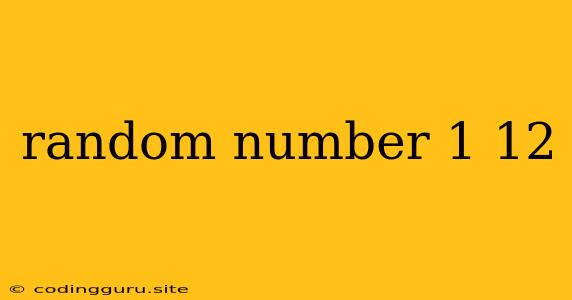Generating Random Numbers Between 1 and 12
The ability to generate random numbers is a fundamental part of many programming tasks. Whether you're simulating dice rolls, creating random data, or building games, understanding how to generate random numbers is essential. In this article, we'll delve into the world of random number generation, focusing specifically on generating random numbers between 1 and 12.
Why Generate Random Numbers?
Before we jump into the code, let's understand why generating random numbers is so useful:
- Simulations: Random numbers are crucial for simulating real-world phenomena, like coin flips, dice rolls, or even complex scientific processes.
- Games: Games heavily rely on random number generation for everything from character stats to loot drops and game events.
- Data Generation: Creating random data is essential for testing software, building mock databases, and conducting statistical analysis.
- Security: Randomness plays a vital role in cryptography and security, helping generate strong passwords, encryption keys, and other secure elements.
Understanding Random Number Generation
At the core of random number generation lies the concept of pseudo-randomness. Computers can't truly produce random numbers; instead, they use algorithms to generate sequences that appear random but are actually deterministic. These algorithms rely on a seed, which is a starting point for the sequence. The same seed will always produce the same sequence of random numbers.
Methods for Generating Random Numbers Between 1 and 12
Let's explore some common methods for generating random numbers within the range of 1 to 12:
1. Using Libraries:
Most programming languages provide built-in libraries that simplify the process of generating random numbers. Here's an example using Python:
import random
random_number = random.randint(1, 12)
print(random_number)
The random.randint(1, 12) function generates a random integer between 1 and 12 (inclusive).
2. The "Modulus" Method:
You can use the modulo operator (%) to restrict the output of a random number generator to a specific range. Here's how:
import random
random_number = random.randrange(12) + 1
print(random_number)
random.randrange(12)generates a random number between 0 and 11 (inclusive).- Adding 1 to the result shifts the range from 0 to 12, effectively giving you a random number between 1 and 12.
3. Manual Implementation:
While using libraries is usually the most efficient approach, it's possible to write a simple function to generate random numbers. This method utilizes the modulo operator and the concept of "seeds":
import time
def generate_random_number(seed):
# Use the current time as a seed for better randomness
seed = (seed * 997) % 2**32
return (seed % 12) + 1
current_time = int(time.time())
random_number = generate_random_number(current_time)
print(random_number)
This function takes a seed value, performs a simple mathematical operation, and uses the modulo operator to generate a random number between 1 and 12.
Considerations for Generating Random Numbers
- Seed Selection: Using the current time or other system-specific variables as a seed can increase the perceived randomness of the numbers.
- Security: If you need to generate truly secure random numbers for cryptography or sensitive applications, you should consult your language's documentation for specific libraries and functions designed for this purpose.
- Reproducibility: If you're working on a project where you need the same sequence of random numbers for testing or debugging, you can set a fixed seed value to ensure consistent results.
Conclusion
Generating random numbers between 1 and 12 is a straightforward process with several different approaches. Choosing the right method depends on your specific needs and the programming language you're using. Remember that true randomness is impossible with computers, but by using appropriate techniques and libraries, you can generate sequences of numbers that appear sufficiently random for most applications.
